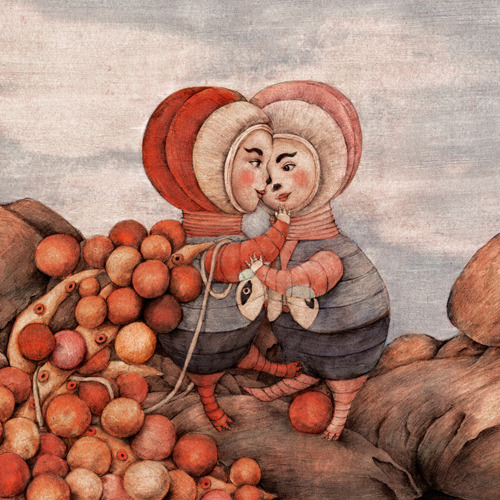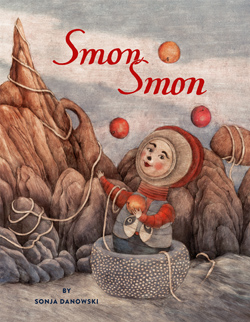< Back to posts
Sonja Danowski
Germany

Sonja Danowski studied design in Nuremberg and has since been working as an illustrator and picturebook artist in Berlin. Her work has been exhibited and published internationally and has won her many awards, including the Golden Island Award from Nami Concours and a Batchelder Honour from the American Library Association.
In this post, Sonja talks about the creation of her latest picturebook ‘Smon Smon’, and she shares lots of illustrations and work in progress. This stunning work is published by NordSüd Verlag in Switzerland and NorthSouth Books in the United States.
Sonja: When I was little, my bed was close to the window and the curtains should not be closed so I could see the night sky with its sparkling stars. I still like that today. I always wondered what’s going on up there, and imagined fantastic beings. While I lay safely in my bed, it felt very cosy, imagining all those peaceful beings and worlds.
I had planned to set a picture book story in my fantasy world for a long while, but I wasn’t quite sure how to start. There is this strange boundary that makes it almost impossible to bring our fantasy into reality without losing all its magic. But reality also brightens our imagination – like when we read a story and mentally visit entire sceneries. It’s also exactly this brightness that makes it possible to illustrate texts. Among others, I’ve illustrated two moving novels by Chinese writer Cao Wenxuan. They take place in China in the 60s and 70s, and I loved the challenge!
Illustrations and films often succeed in capturing the atmosphere, but it is always somehow different from our imagination, or it’s incomplete. With my new book idea, I had the advantage that no one except me had ever visited my fantasy world, so no one could be disappointed by my attempt to depict it. One thing that I particularly love about making picture books is that once I have a book idea, it won’t let me go and everything around me gets a new meaning. In my sketchbook, I noted what might be of importance for the plot: fast-growing mushrooms, plant forms, rock formations…
I use sketches as a tool for development, but I really have to work out an entire scene to immerse myself emotionally in the emerging imagery. Instead of making a whole storyboard, I trust that the result will tell me what’s going to happen next. With my own stories, I always work intuitively, and I especially like inventing fictive places in my illustrations, such as the home of the main characters in my picture book ‘Little Night Cat’.
Inspired by reality, I combine all sorts of things that exist in our world in order to create completely new, fictive spaces out of them. I draw and draw until the scene seems somehow authentic to me and the details tell little stories while looking at them.
With ‘Smon Smon’ I could go a step further. I enjoyed creating a world where the impossible is possible and craziness takes the place of familiarity.
I like natural-white drawing paper with a matte, smooth surface, and so thick it doesn’t curl when wetted. My first pencil drawings are always quite detailed; while playing with shapes and stony structures, I can delve into my drawing for hours, a condition I like so much! I’m not good at simplifying things; I’m a master at losing myself in details and complexity. I’m always impressed with how other artists can create a meaningful drawing with just a few lines and shapes.
When all picture elements had found their place, I could concentrate completely on the colours that added depth, light, shadow and warmth. For colouring, I used ink and watercolours, and for the final touches, sepia and soft crayons. I like ink and watercolour, which always behave unpredictably on paper – much better than I could have planned it – and I’m fascinated by how we perceive colours differently each time in relation to the adjacent tones. The planet was supposed to be a mysterious, surreal, somewhat gloomy place, so I mostly reduced the palette to a few colours that I prefer to paint with: English-red, sepia, sienna, transparent blue, and the myriad of blends.
First, the creature was on four legs and had fur, and the eyes were far too small and kind of scary; it seemed as if it hadn’t made any effort to appeal to me. It took a small eternity for me to find my main character: weird enough to pass as an alien and sweet enough not to scare. I thought that the anatomy of the beings should be adapted to their habitat, and gave Smon Smon (I later called it) an accordion neck that allowed it to pick high-growing fruit and withstand some difficulties in its search for food. I also discovered two other species on the planet: the small and strong Klon Klons and the flying Flon Flons.
Also, the plot is based on the idea of foraging. Everything doesn’t go smoothly for Smon Smon, but of course there is a happy ending. As in my childhood memories, it is a peaceful world; the beings help each other out of serious situations, and they are generous.
Finding the right words for this world happened spontaneously. This sentence came to my mind: ‘The Smon Smon live on the planet Gon Gon.’ Words with double syllables like ‘Mama, Papa’ are of elemental nature, and I found that the form and sound of the vowel ‘O’ went perfectly with the organic environment. Working out the next scenes, I picked up the rhythm and I wrote: ‘In the morning, the Smon Smon hangs its last ron ron next to its won won on a lon lon and floats away in a ton ton.’
I firstly wrote the sentence in German, but then had to test whether it also worked in English and other languages. It worked fine; it can be translated almost literally, without losing the language’s rhythm. I also liked the idea of giving the few characteristic details in my pictures newly invented names, so readers have to puzzle out their meaning and make the connections themselves. With each page and repetition it becomes easier to remember them, and there are also some clues to find in connotations: lon lon are long, ron ons are round, Flon Flons fly…
The more seriously one reads the book’s text aloud, the more absurd and funny it sounds, and the best is that all the nonsense also makes sense.
Creating a comprehensive illustration project means absorbing the story’s atmosphere very intensively. Often I felt as if I lived in my depicted world. I was fortunate to be surrounded by friendly creatures that surprised me with their weirdness and brightened my mood. While drawing, these strange creatures developed a life of their own and encouraged me – despite all the difficulties and self-doubts – to stay the course until the book was completed.
Illustrations © Sonja Danowski. Post edited by dPICTUS.
Smon Smon
Sonja Danowski
NordSüd Verlag, Switzerland, 2018
NorthSouth Books, United States, 2018
Sonja Danowski takes us on a journey into a beautiful, mysterious world where cooperation and generosity save the day.
‘Weird, wonderful, and proof that journeying to places of uncertainty and unfamiliarity can feel extraordinarily exciting.’
—Kirkus Reviews
- German: NordSüd Verlag
- English: NorthSouth Books
- Italian: Orecchio Acerbo
- Romanian: Propublic / Signatura
- Korean: Booklight

























